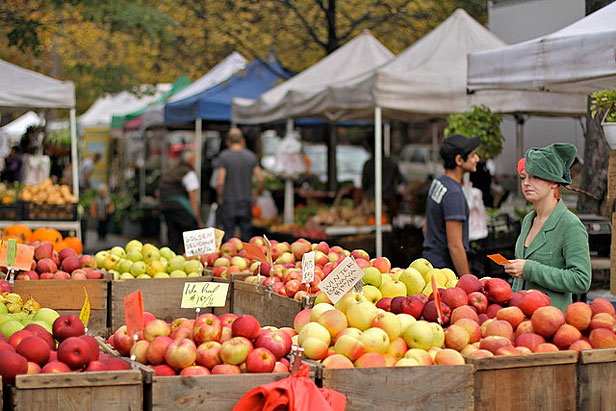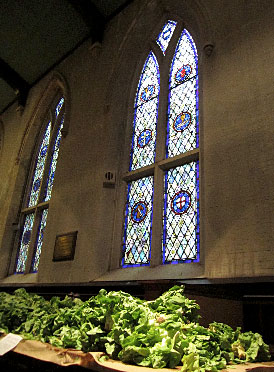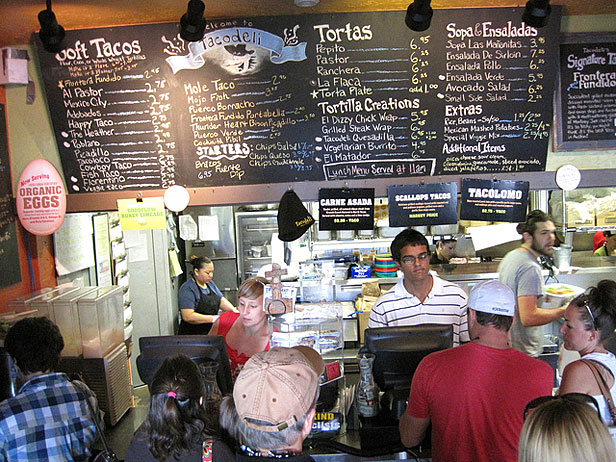 Photo courtesy humanin via Flickr
Photo courtesy humanin via Flickr
A few years ago, I stumbled on a United Nations study that transformed how I think about the climate crisis. In the report, researchers pegged greenhouse gases from the livestock sector at 18 percent of total global emissions. Combine this with other aspects of our food chain — from agricultural chemical production to agribusiness driven deforestation to food waste rotting in landfills — and food and agriculture sector is responsible for nearly one third of the planet’s manmade emissions. Move over Hummer; it’s time to say hello to the hamburger.
It doesn’t take high-level math to realize if we’re serious about averting the climate crisis, we need to add the food chain to our conversation. (Of course, we should be talking about agriculture’s impact on the environment for a host of other reasons, too. Agriculture is the world’s single largest user of land and water, using up 70 percent of the world’s freshwater resources every year. Agriculture is also responsible for widespread air and water pollution and agricultural chemical runoff that causes aquatic dead zones around the world. At last count, there are more than 400, including one in the Gulf of Mexico that swells every year to a size three times larger than the BP oil spill.
Climate-friendly food means more than just following a “green” checklist; it means considering the values underpinning our food system.
So what can we do? Thankfully, we’re learning every day about the power of sustainable food systems to help reduce emissions from the food chain and mitigate the climate crisis.
Now, the “food system” may sound (and feel) like an abstract concept that has nothing to do with the sandwich sitting on your desk for lunch, but it’s all related. And that sandwich you’re about to eat connects you to the livelihoods and fates of farmers and food workers around the world. It also connects you to the climate.
We can, with every food choice we make, align ourselves with a “climate-friendly diet” by choosing to eat sustainably raised food and steer clear of feedlot meat and industrial dairy, for instance. A climate-friendly diet also means going for fresh, whole, real foods, not the processed victuals so typical in our supermarkets, and limiting food packaging and food waste. But a climate-friendly food system means more than just our following a “green” checklist; it means considering the values underpinning this kind of food system, foremost among them ecology, community, and fairness.
That values “frame” is critical, now more than ever. As the food industry catches on that more and more of us care about the climate impacts of our food and that we’re asking more questions about the provenance of what we eat, they’ve stepped up their green marketing messages. McDonald’s recently launched an “Endangered Species” Happy Meal, “to engage kids in a fun and informative way about protecting the environment,” explains project partner Conservation International. A far cry from their GM partnership several years back, which launched the Hummer Happy Meal and ended only after 42 million toy Hummers had been given away. Earlier this year, Sara Lee unleashed with much fanfare a new line of “Earth Grains” bread that promotes “innovative farming practices that promote sustainable land use” as part of what the company calls its “Plot to Save the Earth.”
This new wave of food industry marketing is creating a green-tinged fog for some of us who are trying to sort out what’s truly green and what’s just spin. But, I believe, if we frame a climate-friendly system in core values, we can see more easily through the fog. By shifting the conversation to core values, it’s much harder for the message to be co-opted, no matter the savvy of the marketers.
1. Ecology
Ecology, from the Greek oikos, for house or dwelling, and logia, for the study of, draws attention to the relationships between living things and their environment. Coined in the 1870s, the term took root in the United States in the 1960s as environmentalists strove for a way of emphasizing the importance of these relationships. As we struggle to understand the role that food plays in the climate crisis (both its power to harm and to heal), the value of agroecology is key to our understanding.
Perhaps the clearest case for the need for agroecological systems was expressed in a ground-breaking study released in April 2008 in Johannesburg, South Africa by a consortium of more than 400 scientists from around the world. The report — with the tongue-twistingly long name the International Assessment of Agricultural Knowledge, Science and Technology for Development (IAASTD) — stressed in no uncertain terms the importance of agroecology and small-scale farming and the need for sustainable management of livestock, forest, and fisheries. The IAASTD, as it is known, urges a transition to “biological substitutes for agrochemicals” and “reducing the dependency of the agricultural sector on fossil fuels” to foster a healthy food system and one that will help us mitigate and adapt to the climate crisis.
“We don’t need a single super gene or a super variety that somehow will be a silver bullet approach to climate change. It’s a technological engineering approach to a biological problem.”
–Molly Anderson
Understanding ecology allows us to poke holes in the quick-fix solutions to climate change we’re hearing from agribusiness, like Monsanto’s promotion of genetically engineering seeds to withstand drought. (The company’s recent ad campaign — “How can we squeeze more from a raindrop?” — seems to be in every magazine I’ve picked up lately.) But as Molly Anderson, an expert on agroecology and an author of the IAASTD says: “Climate change is not something you can engineer a gene into a plant for. Climate change is a really complex se
t of processes. We don’t need a single super gene or a super variety that somehow will be a silver bullet approach to climate change. It’s a technological engineering approach to a biological problem.”
When we talk about our ecological food values, we’re focusing on the importance of interconnections and of the complexity of a truly sustainable food system. As agroecological farmers like to remind us, sustainable food is not just defined by the absence of chemicals — it’s about the creation of a healthy ecosystem, especially healthy, carbon-rich soils.
2. Community
 The Green Thumb CSA pickup is in an old church.(Jennifer Prediger photo)Once a week, my one-year old daughter and I stroll the 12 blocks from our apartment to a towering church in Brooklyn’s Cobble Hill neighborhood to gather our fruit and vegetable “share.” My daughter has had her first taste of raspberries, green beans, basil, plums, peaches, summer squash, and more, thanks to the Green Thumb Farm. As “shareholders” in this community-supported agriculture (CSA) farm, we invested at the beginning of the growing season — along with 222 other families — and we all benefit from it weekly. We also share the risk. With the mercury at record highs this summer, the tomatoes have been thriving. Says farmer Bill Halsey of Green Thumb Farm: “Maybe the best of the century, if not longer!” But the lettuce? For the first time in 15 years: Nada.
The Green Thumb CSA pickup is in an old church.(Jennifer Prediger photo)Once a week, my one-year old daughter and I stroll the 12 blocks from our apartment to a towering church in Brooklyn’s Cobble Hill neighborhood to gather our fruit and vegetable “share.” My daughter has had her first taste of raspberries, green beans, basil, plums, peaches, summer squash, and more, thanks to the Green Thumb Farm. As “shareholders” in this community-supported agriculture (CSA) farm, we invested at the beginning of the growing season — along with 222 other families — and we all benefit from it weekly. We also share the risk. With the mercury at record highs this summer, the tomatoes have been thriving. Says farmer Bill Halsey of Green Thumb Farm: “Maybe the best of the century, if not longer!” But the lettuce? For the first time in 15 years: Nada.
Today, advocates say there are between 3,000 and 4,000 CSA programs connecting families directly with farmers across the country. (In the latest agriculture census [PDF], the USDA estimates there are even more: 12,549). Of course, CSAs are just one piece in a patchwork of solutions to reknit regional foodsheds, but more importantly they exemplify the value of community that undergirds a climate-friendly food system. The relationship between farmer Bill and us eaters upends a fundamental principle of the market: that producers and consumers are necessarily opponents.
I got another taste of this profound shift when I traveled to South Korea a few years ago. While there I met with leaders in the consumer cooperative movement. I thought our local Park Slope Food Co-op was impressive with more than 14,000 members. Try 150,000. That’s the membership of just one of several consumer co-ops I met with.
When I sat down with Seong Hee Kim, a leader of the Hansalim co-op, he described its programs connecting farmers with consumers: summer camps on farms for city kids, workshops on sustainable food production, investments in bakeries stocked with local food. The core business of the co-op is the direct sale of hundreds of food items, the prices of which are mostly decided at their annual meeting. When the farmers’ reps and consumer reps sit down together, the conversation always ends in a fight — just not the kind of fight you might imagine. Rice is the most contentious, Kim explains: Without fail, the consumers insist they should support the farmers by paying more than the market price for the rice. The farmers insist that, no, consumers should actually pay less than the market price, since the cost of production is lower than what the market charges.
“And then, they get into a big argument!” said Kim, laughing.
How did Hansalim achieve this shift — from producers and consumers seeing themselves as competitors to seeing themselves as on the same team? The answer, Kim explained, has to do with values — community values. “Our producers see themselves as responsible for the health and well-being of the consumers. And the consumers, they know the farmers and see very clearly how they’re responsible for their well-being,” he said.
3. Fairness
Fairness in the food chain means ensuring that all the workers, farmers, food producers — everyone along the food chain — is treated fairly and gets a fair wage. It also means ensuring all consumers, no matter where they live or what tax bracket they’re in, have access to affordable healthy food.
In 2006, consumer behemoth Wal-Mart, and the nation’s largest grocer, made headlines when it announced its move into organic foods: “Wal-Mart Eyes Organic Foods,” declared The New York Times. Within a year, some of the country’s biggest organic food providers were on board, including the farmer-owned co-op Organic Valley. But as the co-op’s Wal-Mart business grew, it began to short its other customers — and the co-op’s board and CEO, George Siemon, started questioning their decision. Said Siemon in an Inc. Magazine article: “All of a sudden it hit us: What are we doing? [… We’re] treating everybody poorly, and damaging our reputation. We need to decide what’s most important.” Siemon’s biggest concern was that Wal-Mart would become the co-op’s biggest customer, causing Organic Valley to lower its labor and production standards to meet Wal-Mart’s demand for lower prices. For Siemon, the decision to break away from Wal-Mart was clear: “Eventually, Wal-Mart could consume so much milk that the co-op could become beholden to one client and vulnerable to pressure to lower prices — violating its fundamental mission of providing fair prices to farmers.” And so Organic Valley walked away, returning its focus to the mainstay of its business since the mid-1980s: natural foods stores across the country.
Plus, no matter how much Wal-Mart says it’s benefiting the planet and farmers by purchasing organic foods — and the origins and true sustainability of those items have been rigorously questioned — we can remain critical of the company’s flagrant disregard for workers’ rights. Wal-Mart recently admitted to failing to pay overtime, vacation, and other wages totaling $86 million to 232,000 California workers. A host of other class action lawsuits are pending.
An organic peach and the climate crisis
By considering the values of ecology, community, and fairness as a lens through which to understand the connections between food and climate, we can perceive the need to go beyond our plate. We aren’t going to bring these values to life solely by filling our (reusable) shopping bags with real food from farmers we know and workers who were paid a good wage, though that is certainly a good start.
Once we better understand and embrace these three values in relation to the food system, we can see clear ways work to protect — and advance — them. One powerful way to do that is through policy, such as promoting access to healthy foods and ma
king it easier for everyone to connect to farmers. We can see, too, the power of developing uniform, and trusted, product standards such as the organic certification. And finally, we can see the role the government should play in regulating marketing through bodies like the Federal Communication Commission, which has historically created limits to fraudulent green claims on products.
With historic floods devastating as many as 20 million people in Pakistan, a chunk of glacier four times the size of Manhattan breaking free from Greenland, and temperatures from Moscow to New York City hitting historic highs and leaving us all roasted, more and more people are starting to feel the direct impact of what may very well be the signs of climate chaos to come.
In order to get back to the level of greenhouse gas emissions we need to be to stabilize the climate, every sector must play a role. Now, nearly five years after I read that United Nations report about livestock and the climate crisis, it’s ever more visible the role that food systems plays, not only in exacerbating the crisis, but also in helping address it.
Now, I know, with stakes so high, suggesting that a local, organic peach can make a difference might feel laughably inconsequential — but if choosing a local peach is a tasty reminder of our growing, unified, powerful vision for shifting our food system toward a more sustainable model, then it might not be so inconsequential after all.
Reposted with permission from an article Anna Lappé adapted for YES! Magazine, a national, nonprofit media organization that fuses powerful ideas with practical actions, from a speech she gave for National Cooperative Grocers Association. Anna is the author of Diet for a Hot Planet: The Climate Crisis at the End of Your Fork and co-author of Grub: Ideas for an Urban Organic Kitchen and Hope’s Edge. She is a founding principal of the Small Planet Institute.




